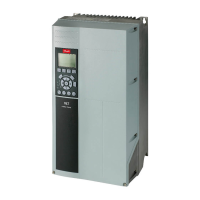3 RS-485 Installation and Set-up
3.1 Introduction
3.1.1 Overview
RS-485 is a two-wire bus interface compatible with multi-
drop network topology, that is, nodes can be connected as
a bus, or via drop cables from a common trunk line. A
total of 32 nodes can be connected to one network
segment.
Repeaters divide network segments.
NOTE
Each repeater functions as a node within the segment in
which it is installed. Each node connected within a given
network must have a unique node address, across all
segments.
Terminate each segment at both ends, using either the
termination switch (S801) of the frequency converters or a
biased termination resistor network. Always use screened
twisted pair (STP) cable for bus cabling, and always follow
good common installation practice.
Low-impedance earth connection of the screen at every
node is important, including at high frequencies. Thus,
connect a large surface of the screen to earth, for example
with a cable clamp or a conductive cable gland. It may be
necessary to apply potential-equalizing cables to maintain
the same earth potential throughout the network - partic-
ularly in installations with long cables.
To prevent impedance mismatch, always use the same
type of cable throughout the entire network. When
connecting a motor to the frequency converter, always use
screened motor cable.
Cable
Screened twisted pair (STP)
Impedance
[Ω]
120
Cable length
[m]
Max. 1200 (including drop lines)
Max. 500 station-to-station
Table 3.1 Cable
3.1.2
Network Connection
Connect the frequency converter to the RS-485 network
as follows (see also Illustration 3.1):
1. Connect signal wires to terminal 68 (P+) and
terminal 69 (N-) on the main control board of the
frequency converter.
2. Connect the cable screen to the cable clamps.
NOTE
Screened, twisted-pair cables are recommended in order to
reduce noise between conductors.
61 68 69
N
P
COMM. GND
130BB795.10
Illustration 3.1 Network Connection
3.1.3 Frequency Converter Hardware Set-
up
Use the terminator switch on the main control board of
the frequency converter to terminate the RS-485 bus.
The factory setting for the switch is OFF.
3.1.4
Frequency Converter Parameter
Settings for Modbus Communication
Define the RS-485 Communicaiton Set-up
Parameter Function
8-30 Protocol Select the application protocol to run on
the RS-485 interface
8-31 Address Set the node address.
NOTE
The address range depends on the
protocol selected in 8-30 Protocol
8-32 Baud Rate Set the baud rate.
NOTE
The default baud rate depends on the
protocol selected in 8-30 Protocol
8-33 Parity / Stop
Bits
Set the parity and number of stop bits.
NOTE
The default selection depends on the
protocol selected in 8-30 Protocol
8-35 Minimum
Response Delay
Specify a minimum delay time between
receiving a request and transmitting a
response. This function is for overcoming
modem turnaround delays.
RS-485 Installation and Set...
VLT
®
AutomationDrive FC 360 Design Guide
MG06B202 - VLT
®
is a registered Danfoss trademark 41
3
3

